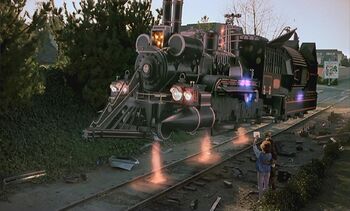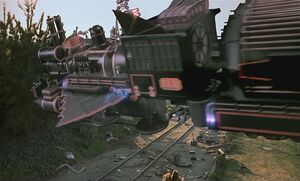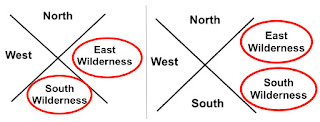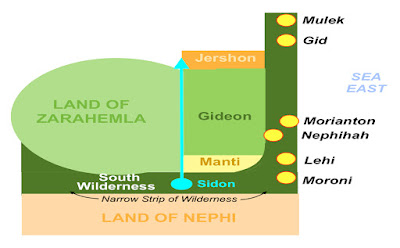Jules Verne Train/Time Train

Built
Creator
Power source
Fate
- "He [Marty] looked up when he heard the sonic boom. / Jennifer jumped from the truck and ran to his side, as they both stared at the steam locomotive rumbling down the tracks. It looked sort of like the locomotive Marty and Doc had stolen — or borrowed, as Doc put it — to get them back to the future. Except somebody had added a few things to the locomotive's working parts, coils, tubes, even a box with a y-shaped gizmo in it that looked a little like a flux capacitor. The whole engine looked like something out of Jules Verne as it braked to a stop beside them."
- —From Back to the Future Part III by Craig Shaw Gardner (quote, page 212)
- "He [Doc] pushed a lever in the locomotive's cab, and, with a rush of steam, the wheels folded underneath the engine and the entire locomotive lifted off the tracks. Doc and his family all waved as the locomotive rose twenty feet in the air, and then proceeded to chug off into the afternoon sky. / After a moment, Marty and Jennifer remembered to wave back, until the locomotive was no more than a speck in the heavens."
- —From Back to the Future Part III by Craig Shaw Gardner (quote, pages 213 and 214)

A rear view of the Jules Verne Train.

The interior of the Jules Verne Train.

The time circuits inside the cabin.
The Jules Verne Train or "Train Time Machine" or simply the "Time Train", labeled "ELB" on each side after its creator, was the culmination of Dr. Emmett Brown's previous experience with building the DeLorean time machine and working with the steam locomotive that pushed it to 88 m.p.h.[1]
Contents
History
The Time Train was a time machine itself that ran off of steam rather than gasoline, built from 1885 to 1895, which took him ten years to build it. When Doc succeeded in its first temporal displacement test, he and his family traveled to 2015 or beyond to give it a hover conversion.
The flux capacitor was still included in this design, in the place of the lamp at the front of the locomotive[2] Unlike the DeLorean, the external components of the Time Train were symmetrical on both sides of the vehicle, possibly representing a more sophisticated grasp of the time travel technology on Doc's part, despite being constructed from more primitive materials.
On October 27, 1985, when Doc met up with Marty McFly and Jennifer Parker, he chose the most likely place that they might be at that given time, the site of the DeLorean's destruction. Interestingly, before the Time Train appeared, it triggered the bells and gates on the nearby railroad crossing as if another train was coming. This could mean that this time machine is so powerful that it enables a connection with its destination time even before arriving to that point of time.
Background information
Although the events of Back to the Future Part III take place in 1885, the locomotive which pushed the DeLorean to 88 m.p.h. was an 1897 model Rogers 4-6-0 mixed traffic engine. The Time Train is a locomotive of the same design as the one that pushed the DeLorean to 88 mph in 1885. However, the two trains cannot be the same locomotive due to the explosion that destroyed the first train, leaving little of the train on the valley floor. The time train had to have been built from another train either purchased by Doc or by him stealing one; the former being more likely since the upper class clothing of the Brown family indicated he had become rich enough to purchase a locomotive of that type.
The train uses technology from the hoverboard that was left behind when Marty left 1885 for 1985. The frictionless dynamo from the hoverboard was able to store multiples of the 1.21 jigowatts that were necessary for time travel. The original flux capacitor built for the train consisted of a wooden box, metal that was arranged as a "Y", and six incandescent light bulbs arranged in a pattern of three on each side of the box. The original time circuits consisted of three mechanical clocks, where the hour, minute and second hands would display where the time machine currently was, where it had been, and where it was going to go.
On June 12, 1893, the Brown family attempted to travel in the Jules Verne train to 1985. Doc had paid a group of railroad workers to lay down fifty yards of track, as he calculated that the distance would be enough to reach 88 mph, since he had improved the performance of the presto logs. The trip failed however, as the train didn't achieve temporal displacement, and crashed.
After seeing a steam tricycle driver driving a Serpollet steam tricycle, Doc decided to use one as a time machine. He used the flux capacitor and the time circuits from the prototype Jules Verne Train. He then donned a diving suit to protect himself from the the stresses of space-time and the temperature variation. He successfully traveled to 2035, where he had planned to pick up everything he needed to complete the Jules Verne Train.
Soon after that, Doc and Marty became aware of Marcus Irving, a rival inventor who intended to finish his own time machine by modifying the DeLorean's flux capacitor. In the incident, the second DeLorean time machine was damaged. While Doc was supposedly still in the process of repairing the car, the reformed Marcus told Marty that it was actually already complete, and theorized that Doc was delaying his return to 1893 because he was not yet ready to take the Jules Verne Train into the future.
Behind the scenes

A front view of the special effects miniature of the Jules Verne Train.
While designing the look for the train, production designer Rick Carter became inspired by the Nautilus from 20,000 Leagues Under the Sea, which seemed an obvious choice considering Doc and Clara's love for the works of Jules Verne. The full-size mock-up of the Time Train still stands at Universal Studios Orlando, even though the ride has since closed.
- In Back to the Future: The Animated Series, the flux capacitor of the train is located on the inside as shown in the episode "Witchcraft".
- A replica of the locomotive (excluding the tender) stood outside the building of Back to the Future: The Ride prior to its closure.
- In the episode "Put on Your Thinking Caps, Kids! It's Time for Mr. Wisdom!", the train had a rope that could be fired from the smoke box door. This was used to latch onto the back of the DeLorean, which Walter Wisdom had stolen.
- The Time Train does not require rails to function as a land vehicle. This can be seen in the episodes "Clara's Folks" and "Put on Your Thinking Caps, Kids! It's Time for Mr. Wisdom!" , in which the train drives on desert ground.
- The Time Train's tender changed slightly during its on-screen appearances: in Back to the Future Part III, the tender had thrusters like the DeLorean time machine; but during Back to the Future: The Animated Series it has a compartment for the new DeLorean time machine to fly into. Whether Doc modified the tender to include this compartment or if there are actually two tenders for the Time Train is perhaps best left to personal preference.
Appearances
- Paradox script
- Back to the Future Part III
- Back to the Future Part III novelization
- Back to the Future: The Animated Series
- Back to the Future: The Card Game
- Back to the Future: The Game
- Back to the Future: The Game - Episode 3: Citizen Brown (Mentioned only)
- Back to the Future: The Game - Episode 4: Double Visions (Mentioned only)








/images/julesvernemix11.jpg)
 Source:
Source:  Source:
Source:  Source:
Source:  Source:
Source:  Source:
Source:  Source:
Source: 


























